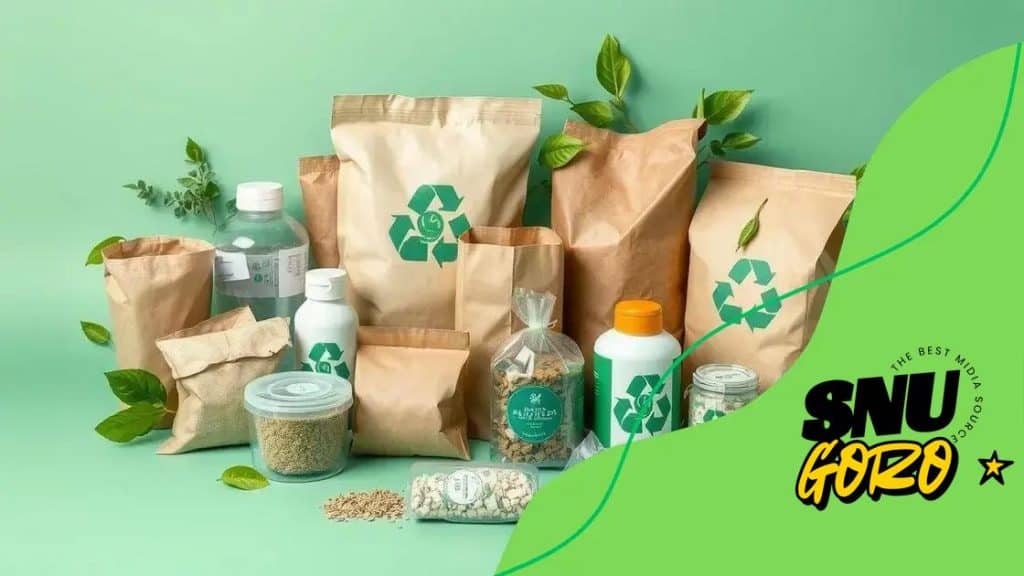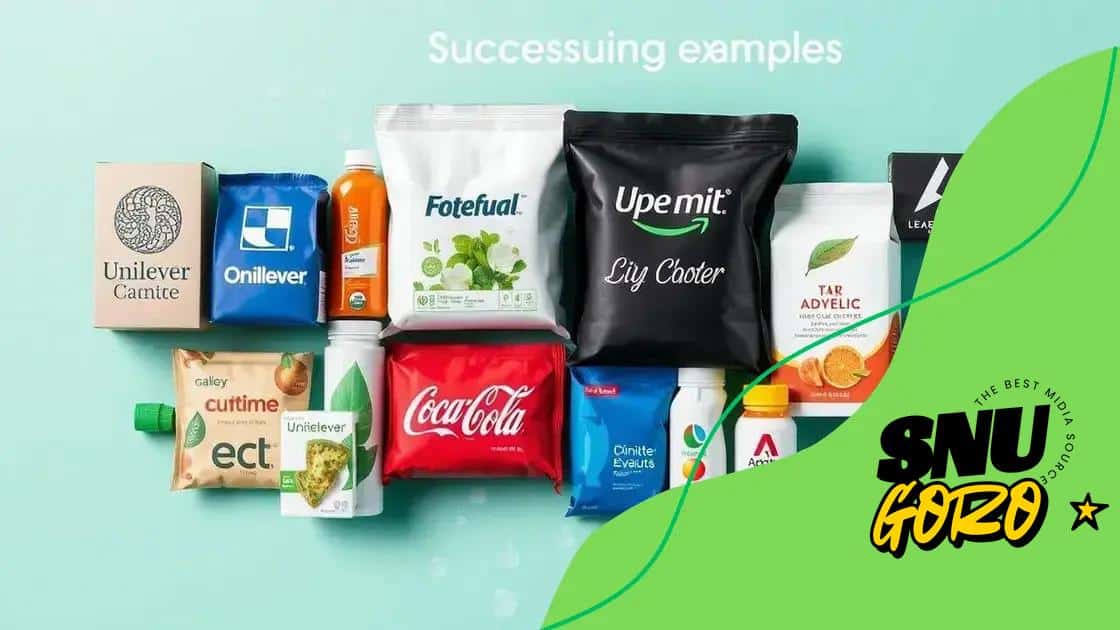Sustainable packaging innovations that transform industries

Sustainable packaging innovations include biodegradable materials, smart packaging, and reusable systems, all aimed at reducing waste and promoting environmental responsibility in the market.
Sustainable packaging innovations are reshaping how businesses approach environmental responsibility. With increased consumer awareness, companies are learning to prioritize eco-friendly options in their packaging strategies. This article explores cutting-edge developments in the field.
The importance of sustainable packaging
The importance of sustainable packaging cannot be overstated. It plays a significant role in reducing waste and promoting a healthier planet. As consumers become more eco-conscious, businesses must adapt to new expectations and adopt innovative approaches.
Environmental Impact
Using sustainable packaging helps minimize environmental damage. Conventional packaging often contributes significantly to pollution and waste. By choosing sustainable alternatives, companies can reduce their carbon footprint and protect natural resources.
Benefits for Brands
Adopting sustainable practices offers numerous advantages for brands. These include:
- Enhanced brand loyalty as consumers prefer eco-friendly options.
- Improved public image and reputation.
- Potential cost savings through efficient resource use.
- Staying ahead of competitors in the market.
Furthermore, sustainable packaging often leads to innovative designs that capture consumer attention. Creativity in packaging allows brands to stand out while promoting environmental awareness.
Moreover, many companies are now focused on educating consumers about the benefits of sustainable options. By sharing information and raising awareness, businesses can contribute to a larger movement towards sustainable packaging.
Innovative materials transforming packaging
Innovative materials are crucial in the evolution of sustainable packaging. These materials not only meet functionality needs but also significantly reduce environmental impact.
Bamboo and Plant-Based Plastics
Among the standout options are bamboo and plant-based plastics. Bamboo, a fast-growing resource, is biodegradable and strong, making it an excellent choice for packaging. Plant-based plastics, derived from renewable resources like corn starch, are gaining popularity due to their reduced carbon footprint.
Recycled Materials
Recycling plays a vital role in sustainable solutions. Using materials that have been reclaimed from waste reduces the demand for new resources. Common recycled packaging materials include:
- Recycled paper and cardboard for boxes and wrappers.
- Glass made from reclaimed bottles, which is infinitely recyclable.
- Recycled plastics, which help close the loop in the production cycle.
Furthermore, innovations in chemistry are leading to new recyclable and biodegradable materials that can replace traditional plastics. These advancements are exciting because they promise to create packaging that is not only effective but also eco-friendly.
Another noteworthy material is mycelium, which is the root structure of mushrooms. This biodegradable option is a game-changer. It can be molded to fit products, providing a protective packaging solution that decomposes quickly.
As these materials gain traction, they inspire manufacturers and consumers alike to rethink how products are packaged. The integration of such innovative materials demonstrates a commitment to protecting the planet while delivering value.
Case studies of successful brands

Examining case studies of successful brands showcases the impact of sustainable packaging innovations. Many companies have embraced these changes, leading to impressive outcomes.
Unilever
Unilever is a prime example of a brand that has prioritized sustainability. They have committed to making all their plastic packaging recyclable, reusable, or compostable by 2025. This initiative not only reduces waste but also aligns with consumer expectations. Their products, like the “Love Beauty And Planet” line, use recycled materials for packaging, demonstrating a strong commitment to eco-friendly practices.
Coca-Cola
Coca-Cola has also pioneered sustainable efforts. By introducing the “World Without Waste” initiative, they aim to collect and recycle a bottle or can for every one they sell by 2030. Their introduction of PlantBottle™, which uses up to 30% plant-based materials, shows innovation in reducing their environmental impact.
Adobe
Adobe has taken significant steps by implementing sustainable packaging on their software products. They utilize 100% recycled paper for packaging, significantly minimizing waste. Their commitment to sustainable materials has not only reduced their carbon footprint but has also resonated with their environmentally aware consumer base.
These brands illustrate the power of embracing sustainable practices. Their successes highlight the benefits, such as enhanced brand loyalty and market competitiveness. By prioritizing sustainable packaging, they not only address environmental issues but also attract a growing demographic of eco-conscious consumers.
Challenges in implementing sustainable solutions
Implementing sustainable solutions in packaging comes with various challenges. Many brands struggle when trying to balance innovation with cost-effectiveness.
Cost Barriers
One of the main issues is the cost associated with developing and using sustainable materials. While these materials offer long-term benefits, they often require higher initial investments. This can discourage smaller businesses from making the switch.
Supply Chain Limitations
Another challenge lies in the supply chain. Many traditional suppliers may not provide eco-friendly materials, forcing companies to find new suppliers. This can complicate production processes and lead to delays.
Consumer Awareness
Consumer awareness is also vital. Many customers may not understand the importance of sustainable packaging or may resist changes. Companies need to invest in educating their customers about the benefits of sustainable options.
Additionally, regulatory standards can vary significantly. Changing laws related to packaging can create confusion and make it difficult for brands to remain compliant while pursuing sustainability.
Moreover, the technology for producing sustainable packaging is still evolving. As companies seek innovative ways to meet demands, they often face obstacles in technology and material science. Continuing research and development are necessary to overcome these hurdles.
Future trends in sustainable packaging
The future of sustainable packaging looks promising with several exciting trends on the horizon. Companies are innovating to meet both consumer demand and environmental challenges.
Biodegradable Materials
One major trend is the rise of biodegradable materials. These materials break down more easily in the environment, reducing waste. Manufacturers are experimenting with alternatives like seaweed, mushroom mycelium, and plant fibers to create packaging that is both effective and eco-friendly.
Smart Packaging
Another trend is smart packaging, which uses technology to enhance the product experience. This can include features such as:
- QR codes providing information on recycling.
- Sensors that monitor freshness or spoilage.
- Packaging that changes color to indicate quality.
Smart packaging not only enhances consumer engagement but also promotes sustainability by helping consumers make informed choices.
Moreover, companies are increasingly focusing on reusable packaging systems. By encouraging consumers to return packaging for reuse, brands can significantly cut down on single-use items in circulation. This model not only helps the environment but also builds stronger consumer relationships.
Finally, there is a rise in circular economy approaches. Businesses are recognizing the value in reusing materials within their supply chains. This shift promotes sustainability at every step, ensuring that resources are utilized efficiently and waste is minimized.
The future of sustainable packaging is bright and full of promise. As we have seen, brands are increasingly adopting innovative materials and practices that not only benefit the environment but also enhance consumer engagement. The movement toward biodegradable materials, smart packaging, and reusable systems shows a strong commitment to reducing waste. By embracing circular economy principles, companies are working to reuse resources efficiently. This shift is essential for a healthier planet, making sustainable packaging a priority for businesses and consumers alike.
FAQ – Frequently Asked Questions about Sustainable Packaging Innovations
What are biodegradable materials?
Biodegradable materials are substances that break down naturally over time, reducing waste and environmental impact.
How does smart packaging work?
Smart packaging incorporates technology, such as QR codes or freshness indicators, to enhance user experience and provide valuable product information.
Why is reusable packaging important?
Reusable packaging helps reduce single-use waste and encourages consumers to participate in sustainable practices.
What is the circular economy?
The circular economy is an economic model focused on reusing resources and minimizing waste, promoting sustainability at every level of production.





